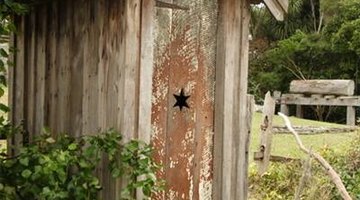How Does an Outhouse Work?
Outhouses are outdoor toilets that are not connected to plumbing systems. Areas such as farms and locations far from city utilities often use outhouses as an only option for a toilet. Outhouses were the traditional toilets before plumbing was invented.

Outhouses
Now that plumbing is available in most areas, the use of outhouses is not as common. When outhouses are used, a more modern version called a composting toilet is usually the preferred option.
Traditional Outhouses
A traditional outhouse, usually a small wood building with a bench, is built over a hole approximately four feet deep. The building has ventilation holes to provide air flow to reduce foul odors inside. Lime is regularly added to the hole to reduce the smell and help break down waste.
Whenever the outhouse smells worse than usual, the owner adds more lime. When the hole fills up, the owner scoops out the waste and hauls it away or uses it to make fertilizer. After the hole is scooped out, it can be used again. (Outhouse waste must be composted before it can safely be used as fertilizer.)
The problem with traditional outhouses is that they can contaminate ground water. The hole does not encapsulate the waste and therefore does not prevent it from leaching into the surrounding soil and nearby water.
Traditional outhouses are rarely used today.
Modern Outhouses
Modern outhouses are also called composting toilets. Composting toilets can be used indoors or outdoors. Composting toilets capture human waste into a container that prevents the waste from polluting ground water sources. Organic materials such as saw dust, wood chips or peat moss are regularly added to the toilet to combine with the human waste. The combined organic materials and human waste biodegrade and turn into a nutrient rich compost. Depending on weather conditions, the waste turns into compost in two months to one year. When the composting toilet is full, the compost is removed and used as fertilizer.
Some composting toilets are more advanced than others. Some have built in fans and heaters to promote decomposition of waste and evaporation of moisture, which reduces the volume of the waste. Smaller volume means that the toilet does not have to be emptied as often.
Outhouse Solutions
If a traditional outhouse needs to be built, evaluate the area first, to make sure there is no underground water source nearby. If it is not possible to avoid an underground water source, a composting toilet should be used.
Resources
Writer Bio
Rose Kivi has been a writer for more than 10 years. She has a background in the nursing field, wildlife rehabilitation and habitat conservation. Kivi has authored educational textbooks, patient health care pamphlets, animal husbandry guides, outdoor survival manuals and was a contributing writer for two books in the Uncle John’s Bathroom Reader Series.
Photo Credits
- Credit: Flying Pete - Copyright: morguefile.com/flyingpete
- Credit: Flying Pete - Copyright: morguefile.com/flyingpete
More Articles



